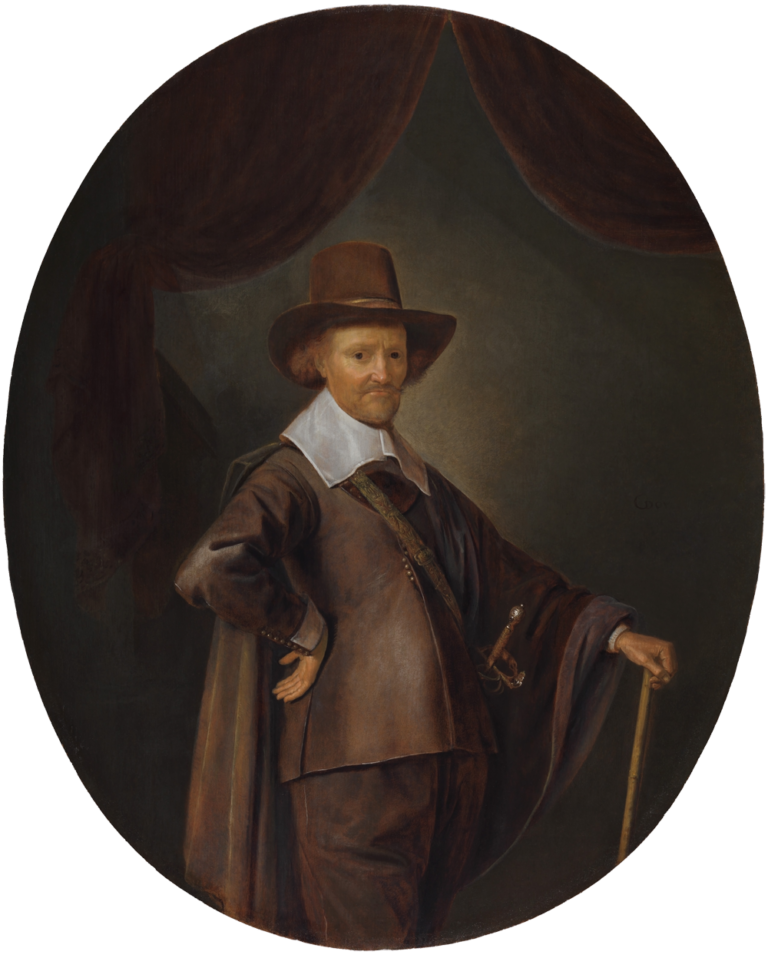Gerrit Dou portrays this dignified man with a penetrating gaze and austere, unsmiling expression, suggesting a stern and forthright individual. He is shown wearing a burgundy-plum woolen suit with a matching cloak draped over his shoulder. An embroidered hanger crossing over his gorget holds a rapier, visible near his hip, indicating his service as an officer in one of Leiden’s two militia companies.1 The military connotation of his attributes correspond with Salomon Savery’s engraving “Standing Officer with Walking Stick,” ca. 1630–35 (fig 1), from a series of prints illustrating officers of rank. Indeed, the man’s stately pose in the present painting, with one hand on a cane and the other nonchalantly resting on his hip akimbo, recalls the pictorial conventions for depicting civic leaders and political dignitaries. Yet rather than a life-size portrait in accordance with those norms, the scale of Dou’s portrait is more intimate and recalls the small-scale portraits of Thomas de Keyser (1596–1667) that had become the vogue in Amsterdam in the 1620s.
This three-quarter length portrait is a pendant to a painting now with the Norton Simon Foundation, Pasadena, Portrait of a Woman, which depicts an equally dignified lady dressed almost exclusively in black (fig 2). The woman’s extended right arm, resting on a table next to a copy of the Statenbijbel and the family’s strongbox, mirrors the man’s pose.2 The complementary poses of the figures, analogous settings, and the similar palette and dimensions of the oval panels leave little doubt that the two portraits were painted as a pair. With this portrait and its pendant Dou provides the perfect visual illustration of the two complimentary social spheres: the male world of public and military affairs, and the private female world of a well-run and pious household3. Although the identity of the couple is unknown, they were most likely part of Leiden’s socioeconomic elite in the early 1640s.4
Marieke de Winkel has identified the man’s kastoor hat as a fashion popular from 1644 to 1646, probably not much earlier or later, about the same time Dou painted Portrait of a Man in the State Hermitage Museum, St. Petersburg (fig 3).5 Both men wear the conical wide-brimmed hat made of felted beaver hair that became fashionable with the opening up of the North American fur trade in the early decades of the seventeenth century.6 The leather sword hangers with intricate tooled designs are also identical and suggest that both men served in a militia company that issued standardized weaponry.7 Another clue supporting a date in the mid-1640s is the similar, broad linen collar worn by a man in a securely dated portrait of 1646, Dou’s Portrait of Johan Wittert van der Aa in the Rijksmuseum.8 Moreover, the asymmetrically draped curtains that theatrically frame the figure within an arched surround is another feature Dou frequently included in the backgrounds of many of his portraits from this period.9
Infrared reflectography reveals that Dou initially sketched an elaborate architectural setting behind the man that included an arched doorway in the center of the composition as well as a column and base at the far left (fig 4).10 It is unclear whether the pendant in Pasadena retains a similar early sketch, for the painting has not undergone infrared examination as of yet.11 In the final composition, Dou separated the figure from the background with a gentle aureole of light, reinforcing the man’s dignity and commanding presence.
